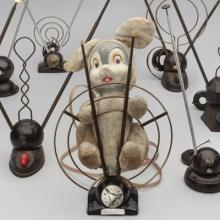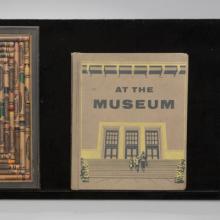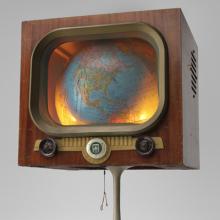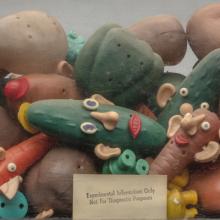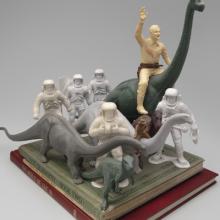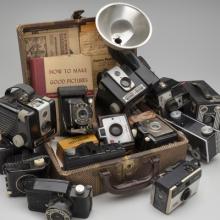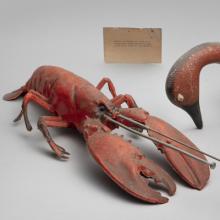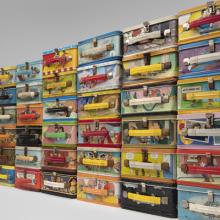Terminal 2












Rabbit Ears 1986
Mickey McGowan (b. 1946)
television antenna, plush and plastic toy
L2023.0301.002a-b
Television antennas 1950s–60s
various makers
L2023.0301.003.01–.13
All objects are courtesy of Mickey McGowan, Unknown Museum Archives
Mickey McGowan
Artist, curator, and archivist Mickey McGowan (b. 1946) grew up in Los Angeles surrounded by experimental art and fashion, live beatnik jazz and rock ‘n’ roll music, surfing, hot rodding, and other elements of Southern California’s booming, pop-cultural scene. McGowan frequented Wallach’s Music City near Playa Del Rey and sampled the latest 45-rpm records. He watched William Castle movies such as House on Haunted Hill—complete with buzzing movie theatre seats and a “flying” skeleton—and underground films by Bruce Conner (1933–2008) and Andy Warhol (1928–87) at Hollywood’s Cinematheque 16. Even the city’s architecture was creative; McGowan recalled being “raised near buildings shaped like giant donuts and hot dogs—I assumed this was the way the world was!” He began collecting as a boy, nailing soda pop bottlecaps to a large, plywood board. McGowan pursued art more seriously in high school, beachcombing for scrap items that he painted and attached to boards as assemblages.
McGowan moved north of San Francisco to Sausalito in 1969, and during the 1970s he made hundreds of pairs of art shoes under the pseudonym Apple Cobbler. In 1973, he rented a former automotive repair shop in nearby Mill Valley as an art studio. One year later, McGowan began collaborating with artist-friend Dickens “44” Bascom (b. 1944), who was famous for his Decorated Car, a 1961 Ford Falcon that was “completely encrusted” in all manner of objects, from toys and tennis shoes to plastic fruit and typewriters. McGowan and Bascom opened the Unknown Museum the following year and invited other local “gluers,” now known as assemblage artists, including Lois Anderson (1927–2004), David Best (b. 1945), and Larry Fuente (b. 1947). By the end of the decade, Bascom moved overseas, and McGowan continued as “resident curator” of the Unknown Museum, a position he still holds today.

[image]
Mickey McGowan at the Unknown Museum on 243 East Blithedale 1986
Ed Smith (active late-20th century)
Mill Valley, California
Courtesy of Mickey McGowan, Unknown Museum Archives
R2023.0301.004
At The Museum 1956
Ruth H. Dudley
Melmont Publishers | Los Angeles
L2023.0301.007.01
Crayola Study 1977
Mickey McGowan (b. 1946)
Crayola Crayons, picture frame
L2023.0301.007.02
Unknown Museum lectern top mid-20th century
Masonite, wood, velvet
L2023.0301.007.03
Unknown Museum guestbooks 1970s–80s
L2023.0301.009.01–.05
All objects are courtesy of Mickey McGowan, Unknown Museum Archives
This Is Your Life: Visiting the Unknown Museum
The Unknown Museum’s mission is to challenge visitors with recollections of items they may have lived with, and to suggest the influence of those objects on popular culture and the American public. When walking into the Unknown Museum’s front yard at 243 East Blithedale Avenue in Mill Valley, visitors were greeted by a wood-framed mirror that proclaimed, “This Is Your Life.” While Mickey McGowan has expressed thoughts and opinions through the Unknown Museum, at times editorializing on current events in a “visual newscast” to introduce alternative viewpoints, many of his artworks and installations are lighthearted and open-ended.
The Unknown Museum provides a calm-yet-stimulating setting to engage in a multitude of ideas and to reflect on past experiences and current issues. In its first two locations, visitors recorded their thoughts and observations in guestbooks placed throughout the museum. A general guestbook near the entrance logged dates and names, comments, and sometimes even impromptu art. The bridal exhibit upstairs included a guestbook and instructions to fill a vial with rice and to, “make a wish, throw rice at the bride.” At the Mr. Peanut display, visitors recorded their recollections of the advertising icon in another guestbook and were invited to take a handful of peanuts and cast spent shells on the floor.

[image]
Museum Front Door c. 1981
Mickey McGowan (b. 1946)
Mill Valley, California
Courtesy of Mickey McGowan, Unknown Museum Archives
R2023.0301.001.001
Television Remote Controls 1988
Mickey McGowan (b. 1946)
various remote controls, mannequin hand, drawers
Courtesy of Mickey McGowan, Unknown Museum Archives
L2023.0301.005.01–.15; L2023.0301.006.01–.18
Television, Popular Culture, and the Perfect Moment
Television asserted a profound influence on mid-twentieth-century America, guiding popular culture, public taste, and the consumption of mass-produced goods. A relatively new invention, only a few thousand television sets were operational in 1946, located near metropolitan areas within range of limited broadcast service. In 1950, Americans owned approximately six million televisions; that number skyrocketed to more than fifty million by the end of the decade when at least one TV set was installed in most American homes. As network programming extended from coast to coast, watching television became ritual behavior, offering reality, escapism, and communal interaction that altered personal schedules and family dynamics.
The Unknown Museum has prominently featured the television. Mickey McGowan utilized hollowed-out sets as enclosures for many of his dioramas. He assembled stacks of televisions in various outdoor yard installations. At times, McGowan adjusted the signal of a working television placed in an indoor exhibit so all that appeared on the screen was a solitary horizontal line. He mixed jingles from early TV commercials onto audio tapes that played music and excerpts from movies, sitcoms, serials, and newscasts from the era. Audio volume rose and fell in a constant soundtrack; the “Perfect Moment” occurred when a direct connection was made—for example, if the Rice Krispies jingle randomly played while a visitor was looking at the ad characters Snap, Crackle, and Pop in the kitchen area of the museum.

[image]
Upside-Down TV 1978
Mickey McGowan (b. 1946)
Mill Valley, California
Courtesy of Mickey McGowan, Unknown Museum Archives
R2023.0301.001.039
The World is on Television Today c. 1987
Mickey McGowan (b. 1946)
television cabinet, globe, lighting, stand
Courtesy of Mickey McGowan, Unknown Museum Archives
L2023.0301.056a-b
“(As a boy) I had free access to television, which of course goes hand in hand with pop culture. TV has been my biggest influence; it started about the year I was born, and I’m a perfect example of what it can do to you—for better or for worse.” —Mickey McGowan, 1993

[image]
243 East Blithedale, Mill Valley c. 1986
Mickey McGowan (b. 1946)
Mill Valley, California
Courtesy of Mickey McGowan, Unknown Museum Archives
R2023.0301.001.015
Not For Diagnostic Purposes 1982
Mickey McGowan (b. 1946)
aquarium, toy figures, sand
Courtesy of Mickey McGowan, Unknown Museum Archives
L2023.0301.088a-c
“Remember the ‘70s—when the ‘What Is Art?’ question was uppermost in people’s minds? At the Unknown Museum, people would point to a pile of old teddy bears and Humpty Dumptys and ask, ‘Is this art?’ and I’d reply, ‘Possibly!”—Mickey McGowan, 1993

[image]
Mr. Potato Head (preserved version) 1982
Mickey McGowan (b. 1946)
Mill Valley, California
Courtesy of Mickey McGowan, Unknown Museum Archives
R2023.0301.001.063
Evolution 1984–ongoing
Mickey McGowan (b. 1946)
plastic dinosaurs, toy figures, books
Courtesy of Mickey McGowan, Unknown Museum Archives
L2023.0301.070.01-.15
“I try to supply fifty percent of the experience. The rest is up to the viewer.” —Mickey McGowan, April 1987

[image]
Front Window Emerging Horse c. 1981
Mickey McGowan (b. 1946)
Mill Valley, California
Courtesy of Mickey McGowan, Unknown Museum Archives
R2023.0301.001.033
Suitcase with Cameras 1984–ongoing
Mickey McGowan (b. 1946)
suitcase, cameras, photographs, film canisters, negatives, pamphlets
Courtesy of Mickey McGowan, Unknown Museum Archives
L2023.0301.010.01, .03–.19
How to Make Good Pictures 1984
Mickey McGowan (b. 1946)
book, camera
Courtesy of Mickey McGowan, Unknown Museum Archives
L2023.0301.010.02
A Snapshot in Time: Personal Photography
Personal photography provides snapshot glimpses of our daily lives. For more than a century, countless personal photographs have informally documented special events and meaningful moments—an important part of the Unknown Museum. Mickey McGowan acquired the bulk of objects in the museum, including snapshot photographs and personal cameras, from sources throughout the San Francisco Bay Area. To McGowan, these personal photographs represent the diverse individuals, families, and friends who originally owned items in the Unknown Museum’s collection.
Personal cameras trace back to 1900, when Eastman Kodak debuted the world’s first affordable camera, the ingeniously simple Brownie. They also made compact folding Brownies, such as the Vest Pocket Model B on display that McGowan glued into a copy of Kodak’s How to Make Good Pictures. McGowan first assembled Suitcase with Cameras at the Unknown Museum in 1984, modifying it for the museum’s subsequent locations.

[images]
Snapshot photographs 1940s–60s
Courtesy of Mickey McGowan, Unknown Museum Archives
R2023.0301.133.01–.08
Under Cover 1983
Mickey McGowan (b. 1946)
book, sunglasses
L2023.0301.065
Talk 1982
Mickey McGowan (b. 1946)
book, novelty teeth
L2023.0301.059
Houdini 1983
Mickey McGowan (b. 1946)
book, chain, padlock
L2023.0301.058
All objects are courtesy of Mickey McGowan, Unknown Museum Archives
The books shown above, along with How to Make Good Pictures, which is displayed in Suitcase with Cameras in the previous slide, are from a series that Mickey McGowan exhibited at SF Camerawork in the early 1980s.

[image]
Shipwrecked Aquaman 1981
Mickey McGowan (b. 1946)
Mill Valley, California
Courtesy of Mickey McGowan, Unknown Museum Archives
R2023.0301.001.017
mutant; an animal or plant with inheritable characteristics that differ from those of the parents. 1984
Mickey McGowan (b. 1946)
toy elephant, duck decoy, fake lobster, antennae
Courtesy of Mickey McGowan, Unknown Museum Archives
L2023.0301.075a-c
“When setting up the Museum, I assumed that other people had the same memories I had. I was an average American kid and that’s what gave me my credentials.”—Mickey McGowan, 1993

[image]
Commuters (museum vehicle) c. 1980
Mickey McGowan (b. 1946)
Mill Valley, California
Courtesy of Mickey McGowan, Unknown Museum Archives
R2023.0301.001.026
Lunchboxes 1950s–80s
various makers
Courtesy of Mickey McGowan, Unknown Museum Archives
L2023.0301.012–.054
Conceptual Art and the Personal Scavenger Hunt
Many of the assemblages in the Unknown Museum were conceived as conceptual art, inviting people to embark on their own unique “personal scavenger hunt.” When confronted with so many common objects from years past, visitors often asked Mickey McGowan to see a specific item, and then proceeded to search for it among a multitude of similar things. The process evoked familiarity, comfort, and was thought-provoking. McGowan recalled a “special kind of laughter” heard from visitors, “not like you hear at comedy shows, but more like some incredible kind of therapeutic release, which was laughter but also joy and reminiscence–a rekindling.” These personal connections are the “secrets” behind the Unknown Museum.
The Unknown Museum was conceived as a hands-on experience, encouraging visitors to physically interact with stacks and shelves full of items. During the museum’s early years, it acquired children’s lunchboxes in earnest because of their availability, utility, and nostalgic value. Found at garage sales, flea markets, and estate liquidations, lunchboxes were obtained in mass quantity and became one of the museum’s signature objects. Collected long before they became collectable, the Unknown Museum saved many of these iconic metal lunchboxes from simply being discarded. McGowan also combined conceptual art with physical utility; towering columns of lunchboxes, stacked from floor to ceiling at the museum on 39 Corte Madera Avenue in Mill Valley, kept sections of the deteriorating building’s ceiling tiles from falling onto the floor.

[image]
Wall of Lunchboxes at Museum 1992
Mickey McGowan (b. 1946)
Mill Valley, California
Courtesy of Mickey McGowan, Unknown Museum Archives
R2023.0301.001.028
He existed on a steady diet of junk food 1982
Mickey McGowan (b. 1946)
Visible Man model, miniature fake food, toy refrigerator, fake food
L2023.0301.067.01-.04, .32–.55
Food packaging and fake food 1950s–70s
various makers
L2023.0301.067.05–.31
All objects are courtesy of Mickey McGowan, Unknown Museum Archives
“In keeping with physical fitness trends, I was always hoping that visitors, by viewing some forgotten object, might be exercising that area of the brain which holds onto the memory cells.”—Mickey McGowan, December 2022

[image]
Colonel Sanders Contemplating the Egg 1978
Mickey McGowan (b. 1946)
Mill Valley, California
Courtesy of Mickey McGowan, Unknown Museum Archives
R2023.0301.001.022
Lucy (still living) meals—three times daily 1982
Mickey McGowan (b. 1946)
jar, toy figure, sand
L2023.0301.101
Football (American c. 1973) 1987
Mickey McGowan (b. 1946)
jar, football
L2023.0301.097
Atomic Insect (found only in Nevada, Utah, and New Mexico) 1983
Mickey McGowan (b. 1946)
jar, toy insect
L2023.0301.106
All objects are courtesy of Mickey McGowan, Unknown Museum Archives
“My original intent was to rescue these items, to provide them with a rest home for the remainder of their days.” —Mickey McGowan, May 1988

[image]
Front Window Display 1979
Mickey McGowan (b. 1946)
Mill Valley, California
Courtesy of Mickey McGowan, Unknown Museum Archives
R2023.0301.001.080
